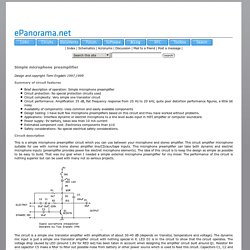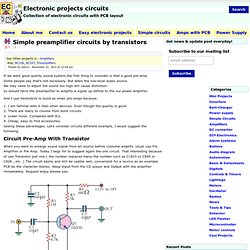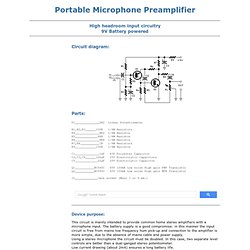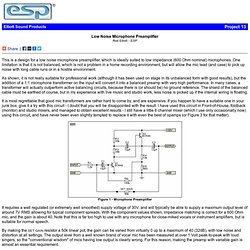

Simple Microphone Preamplifier. Design and copyright Tomi Engdahl 1997,1999 Summary of circuit features Brief description of operation: Simple microphone preamplifier Circuit protection: No special protection circuits used Circuit complexity: Very simple one transistor circuit Circuit performance: Amplification 35 dB, flat frequency response from 20 Hz to 20 kHz, quite poor distortion performance figures, a little bit noisy Availability of components: Uses common and easily available components Design testing: I have built few microphone preamplifiers based on this circuit and theu have worked without problems.

Applications: Interface dynamic or electret microphone to a line level audio input in HIFI amplifier or computer soundcard. Power supply: 9V battery, takes less than 10 mA current Estimated component cost: Electronics components than $10 Safety considerations: No special electrical safety considerations. Circuit description The circuit is bet to build to a small metal box like in the picture above. Component list. Audio Schematics - Preamplifiers Circuits - Electronics Tutorials & Circuits - Discover Engineering Hobby Projects. 4.5 H. Magnetic P.B. Head PreAmplifier Altec 1564A Preamp Power Supply Altec 428B Microphone Preamplifier schematic API 321 mic preamp schematic Audio Pre-Amplifier Audio PreAmplifier (Reconnsworld) - this is a very easy circuit to build, all parts can be found at the local electronics shop, no matter how worthless it (the local shop,) usually is..
ECM Mic Preamplifier. Circuit : Andy CollinsonEmail : Description: A microphone amplifier that may be used with either Electret Condenser Microphone (ECM) inserts or dynamic inserts, made with discrete components.

Notes: Both transistors should be low noise types. In the original circuit, I used BC650C which is an ultra low noise device. These transistors are now hard to find but BC549C or BC109C are a good replacement. The circuit is self stabilizing and will set its quiescent point at roughly half the supply voltage at the emitter of Q2. The electret condenser microphone (ECM) contains a very sensitive microphone element and an internal FET preamp, a power supply in the range 2 to 10 volts DC is therefore necessary. The 1k resistor limits the current to the mic. The second stage, built around Q2 is direct coupled, this minimizes phase shift effects (introduced with capacitive and inductive coupling methods) and achieves a flat output response from 20Hz to over 100kHz. Pre amplifier with transistors BC548. See Other projects in : Amplifiers And: BC109, BC547, Preamplifiers Posted by admin - November 21, 2012 at 12:04 am If we want good quality sound system,the first thing to consider is that a good pre-amp.

Portable Microphone Preamplifier - RED - Page49. Circuit diagram: Parts: P1______________2K2 Linear Potentiometer R1,R2,R3______100K 1/4W Resistors R4______________8K2 1/4W Resistor R5_____________68R 1/4W Resistor R6______________6K8 1/4W Resistor R7,R8___________1K 1/4W Resistors R9____________150R 1/4W Resistor C1______________1µF 63V Polyester Capacitor C2,C3,C4______100µF 25V Electrolytic Capacitors C5_____________22µF 25V Electrolytic Capacitor Q1___________BC560C 45V 100mA Low noise High gain PNP Transistor Q2___________BC550C 45V 100mA Low noise High gain NPN Transistor J1_____________Jack socket (Mono 3 or 6 mm.)

Device purpose: This circuit is mainly intended to provide common home stereo amplifiers with a microphone input. The battery supply is a good compromise: in this manner the input circuit is free from mains low frequency hum pick-up and connection to the amplifier is more simple, due to the absence of mains cable and power supply. Low Noise Microphone Preamp. Low Noise Microphone PreamplifierRod Elliott - ESP This is a design for a low noise microphone preamplifier, which is ideally suited to low impedance (600 Ohm nominal) microphones.

One limitation is that it is not balanced, which is not a problem in a home recording environment, but will allow the mic lead (and case) to pick up noise with long cable runs or in a hostile environment. As shown, it is not really suitable for professional work (although it has been used on stage in its unbalanced form with good results), but the addition of a 1:1 microphone transformer on the input will convert it into a balanced preamp with very high performance. In many cases, a transformer will actually outperform active balancing circuits, because there is (or should be) no ground reference. The shield of the balanced cable must be earthed of course, but in my experience with live music and studio work, less noise is picked up if the internal wiring is floating.
Low Noise Balanced Microphone Preamp. Low Noise Balanced Microphone PreampBy Phil Allison (Edited by Rod Elliott - ESP) Updated 17 May 2008 Please Note: PCBs are available for this project.

Click the image for details. Introduction This simple design has very low noise, close to the theoretical minimum, high hum rejection and variable gain with a single rotary pot. It is similar to that used in many professional grade mixing desks and can form the basis of a no compromise recording mixer for live work. The design consists of differential compound pairs of transistors with a common mode (floating) gain control connecting the emitters of the pair. Full gain is 1000 times or 60dB. Description The input stage is configured for least noise and this has meant a non IC approach. Components should all be readily available except for the 10 k ohm pot for the gain control. Editor's Note - Alternatively, a standard log pot can be used, but wired "backwards".